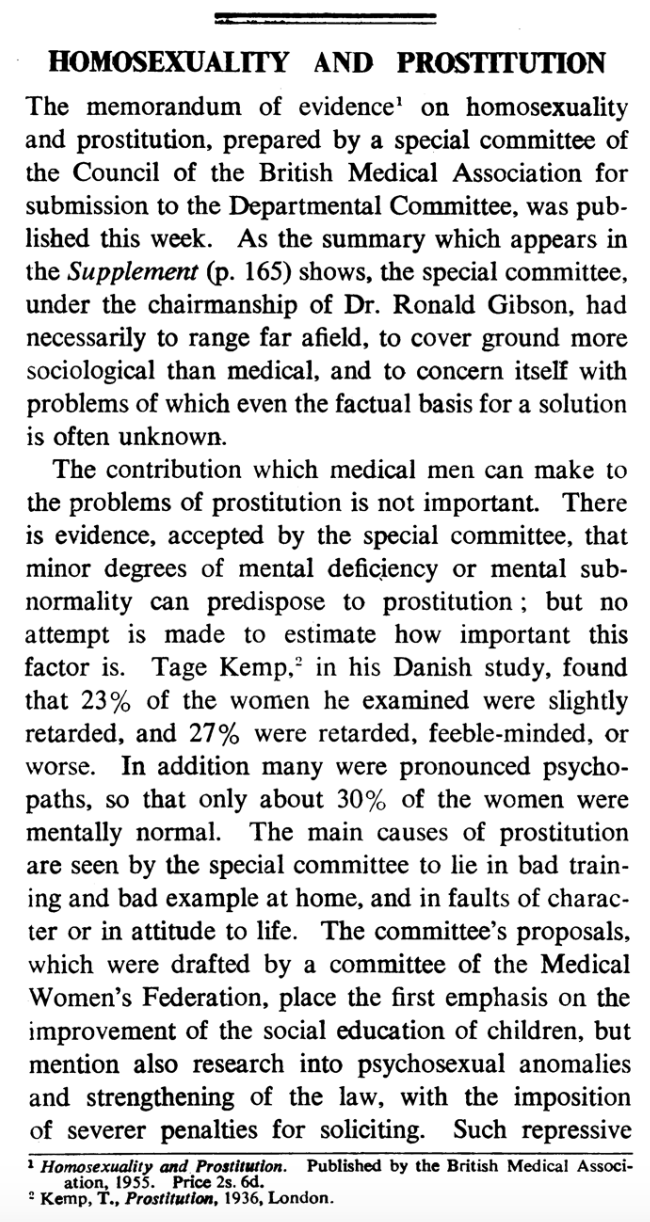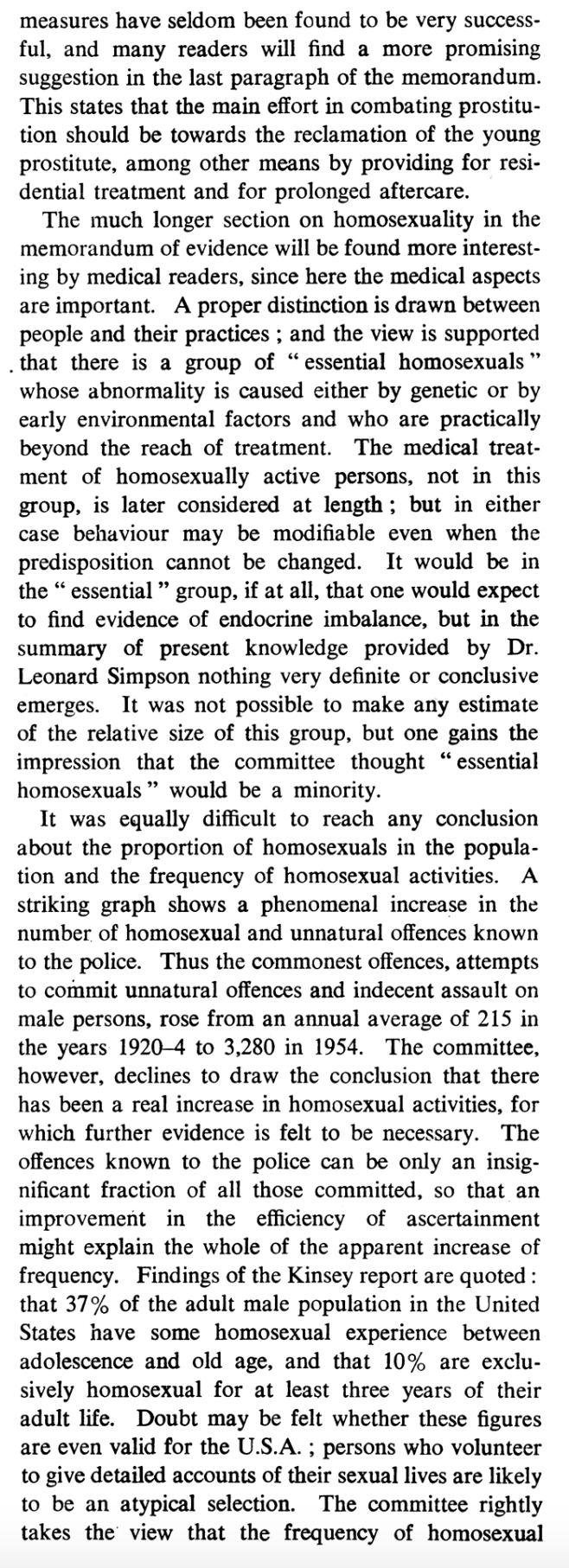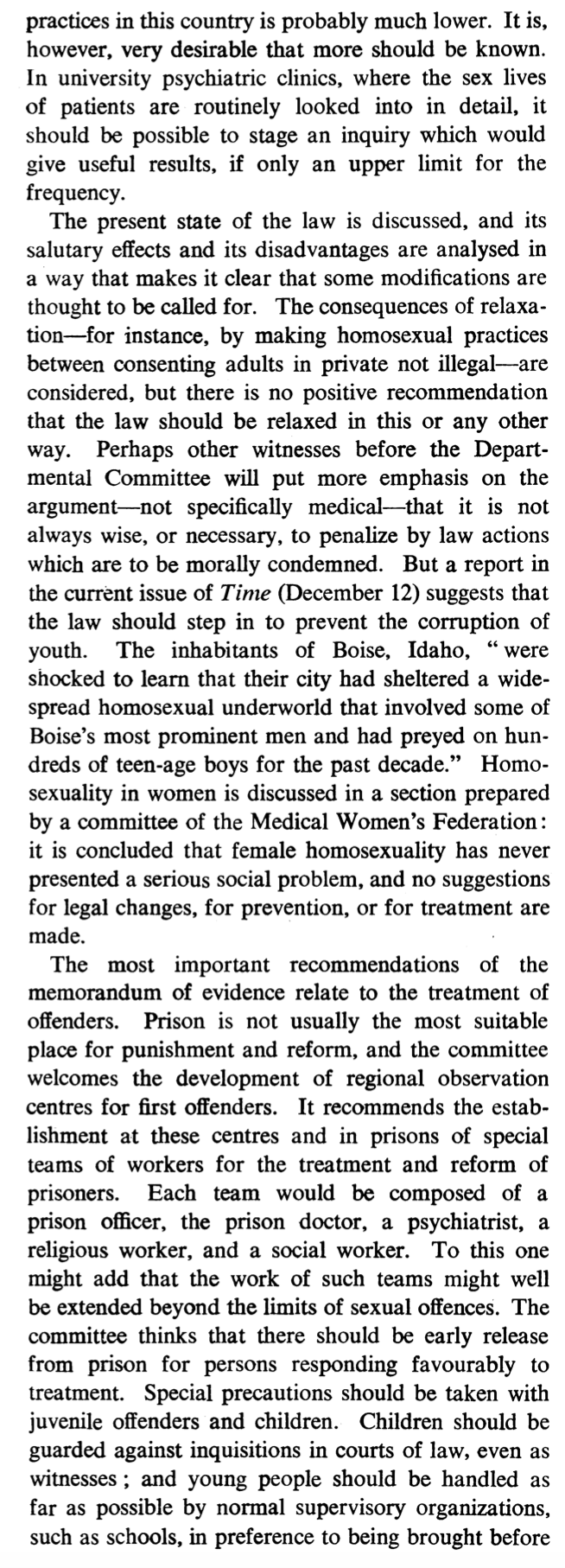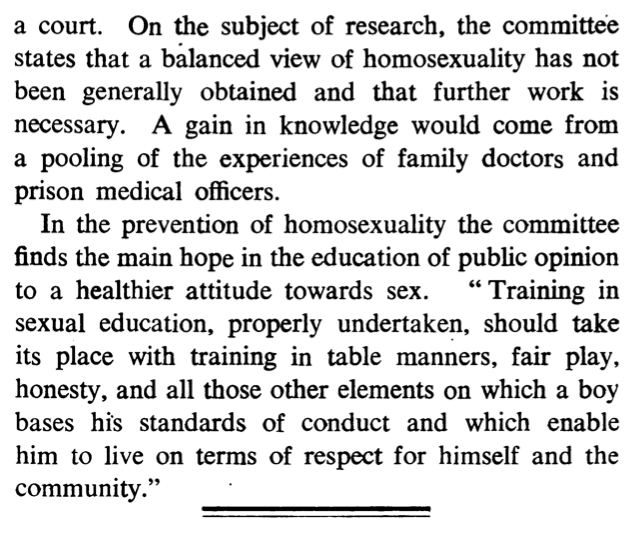British Medical Journal publishes a report from the Departmental Committee on homosexuality.
- Type
- Academic / Technical Report
- Source
- British Medical Journal Non-LDS
- Hearsay
- Direct
- Reference
"Homosexuality and Prostitution," British Medical Journal 2, no. 4954 (December 17, 1955): 1492-1493
- Scribe/Publisher
- British Medical Journal
- People
- British Medical Journal
- Audience
- N/A
- Transcription
HOMOSEXUALITY AND PROSTITUTION
The memorandum of evidence’ on homosexuality and prostitution, prepared by a special committee of the Council of the British Medical Association for submission to the Departmental Committee, was pub-lished this week. As the summary which appears in the Supplement (p. 165) shows, the special committee, under the chairmanship of Dr. Ronald Gibson, had necessarily to range far afield, to cover ground more sociological than medical, and to concern itself with problems of which even the factual basis for a solution is often unknown.
The contribution which medical men can make to the problems of prostitution is not important. There is evidence, accepted by the special committee, that minor degrees of mental deficiency or mental sub-normality can predispose to prostitution; but no attempt is made to estimate how important this factor is. Tage Kemp,2 in his Danish study, found that 23% of the women he examined were slightly retarded, and 27% were retarded, feeble-minded, or worse. In addition many were pronounced psycho paths, so that only about 30% of the women were mentally normal. The main causes of prostitution are seen by the special committee to lie in bad train-ing and bad example at home, and in faults of charac-ter or in attitude to life. The committee’s proposals which were drafted by a committee of the Medical Women’s Federation, place the first emphasis on the improvement of the social education of children, but mention also research into psychosexual anomalies and strengthening of the law, with the imposition of severer penalties for soliciting. Such repressive measures have seldom been found to be very success-ful, and many readers will find a more promising suggestion in the last paragraph of the memorandum.
This states that the main effort in combating prostitu-tion should be towards the reclamation of the young prostitute, among other means by providing for resi-dential treatment and for prolonged aftercare. The much longer section on homosexuality in the memorandum of evidence will be found more interest-ing by medical readers, since here the medical aspects are important. A proper distinction is drawn between people and their practices ; and the view is supported. that there is a group of “essential homosexuals” whose abnormality is caused either by genetic or by early environmental factors and who are practically beyond the reach of treatment. The medical treat-ment of homosexually active persons, not in this group, is later considered at length; but in either case behaviour may be modifiable even when the predisposition cannot be changed. It would be in the “ essential ” group, if at all, that one would expect to find evidence of endocrine imbalance, but in the summary of present knowledge provided by Dr. Leonard Simpson nothing very definite or conclusive emerges. It was not possible to make any estimate of the relative size of this group, but one gains the impression that the committee thought “ essential homosexuals” would be a minority.
It was equally difficult to reach any conclusion about the proportion of homosexuals in the popula-tion and the frequency of homosexual activities. A striking graph shows a phenomenal increase in the number of homosexual and unnatural offences known to the police. Thus the commonest offences, attempts to commit unnatural offences and indecent assault on male persons, rose from an annual average of 215 in the years 1920-4 to 3,280 in 1954. The committee, however, declines to draw the conclusion that there has been a real increase in homosexual activities, for which further evidence is felt to be necessary. The offences known to the police can be only an insig-nificant fraction of all those committed, so that an improvement in the efficiency of ascertainment might explain the whole of the apparent increase of frequency. Findings of the Kinsey report are quoted : that 37% of the adult male population in the United States have some homosexual experience between adolescence and old age, and that 10% are exclu-sively homosexual for at least three years of their adult life. Doubt may be felt whether these figures are even valid for the U.S.A. ; persons who volunteer to give detailed accounts of their sexual lives are likely to be an atypical selection. The committee rightly takes the view that the frequency of homosexual practices in this country is probably much lower. It is, however, very desirable that more should be known. In university psychiatric clinics, where the sex lives of patients are routinely looked into in detail, it should be possible to stage an inquiry which would give useful results, if only an upper limit for the frequency.
The present state of the law is discussed, and its salutary effects and its disadvantages are analysed in a way that makes it clear that some modifications are thought to be called for. The consequences of relaxa-tion—for instance, by making homosexual practices between consenting adults in private not illegal—are considered, but there is no positive recommendation that the law should be relaxed in this or any other way. Perhaps other witnesses before the Depart-mental Committee will put more emphasis on the argument—not specifically medical—that it is not always wise, or necessary, to penalize by law actions which are to be morally condemned. But a report in the current issue of Time (December 12) suggests that the law should step in to prevent the corruption of youth. The inhabitants of Boise, Idaho, “ were shocked to learn that their city had sheltered a wide-spread homosexual underworld that involved some of Boise's most prominent men and had preyed on hun-dreds of teen-age boys for the past decade.” Homo-sexuality in women is discussed in a section prepared by a committee of the Medical Women’s Federation: it is concluded that female homosexuality has never presented a serious social problem, and no suggestions for legal changes, for prevention, or for treatment are made.
The most important recommendations of the memorandum of evidence relate to the treatment of offenders. Prison is not usually the most suitable place for punishment and reform, and the committee welcomes the development of regional observation centres for first offenders. It recommends the estab-lishment at these centres and in prisons of special teams of workers for the treatment and reform of prisoners. Each team would be composed of a prison officer, the prison doctor, a psychiatrist, a religious worker, and a social worker. To this one might add that the work of such teams might well be extended beyond the limits of sexual offences. The committee thinks that there should be early release from prison for persons responding favourably to treatment. Special precautions should be taken with juvenile offenders and children. Children should be guarded against inquisitions in courts of law, even as witnesses ; and young people should be handled as far as possible by normal supervisory organizations, such as schools, in preference to being brought before a court. On the subject of research, the committee states that a balanced view of homosexuality has not been generally obtained and that further work is necessary. A gain in knowledge would come from a pooling of the experiences of family doctors and prison medical officers.
In the prevention of homosexuality the committee finds the main hope in the education of public opinion to a healthier attitude towards sex. “Training in sexual education, properly undertaken, should take its place with training in table manners, fair play, honesty, and all those other elements on which a boy bases his standards of conduct and which enable him to live on terms of respect for himself and the community.”
- Source Link
- https://www.jstor.org/stable/20333865
- Citations in Mormonr Qnas
The B. H. Roberts Foundation is not owned by, operated by, or affiliated with the Church of Jesus Christ of Latter-day Saints.




